Introduction to Marketing: Wearable Technology's Consumer Impact
VerifiedAdded on 2022/09/16
|8
|2143
|15
Report
AI Summary
This report delves into the significant impact of wearable technology on consumer lifestyles, focusing on the Australian market and its global implications. It explores the evolution of wearable devices like smartwatches and activity trackers, highlighting their diverse applications and the increasing competition among businesses. The report examines both the advantages, such as improved connectivity, health tracking, and safety features, and the disadvantages, including high costs, battery life limitations, privacy concerns, and potential health risks. It further analyzes the impact of wearable technology on health outcomes, discussing studies that evaluate their effectiveness in weight loss programs and other health initiatives. The report also touches upon the integration of wearable devices in clinical settings for data collection and analysis, as well as the potential for cost savings in healthcare. The conclusion emphasizes the transformative effects of wearable technology on consumer behavior, acknowledging both its positive and negative aspects, and its evolving role in shaping modern lifestyles. The report references various academic sources to support its claims and provides a comprehensive overview of the topic.
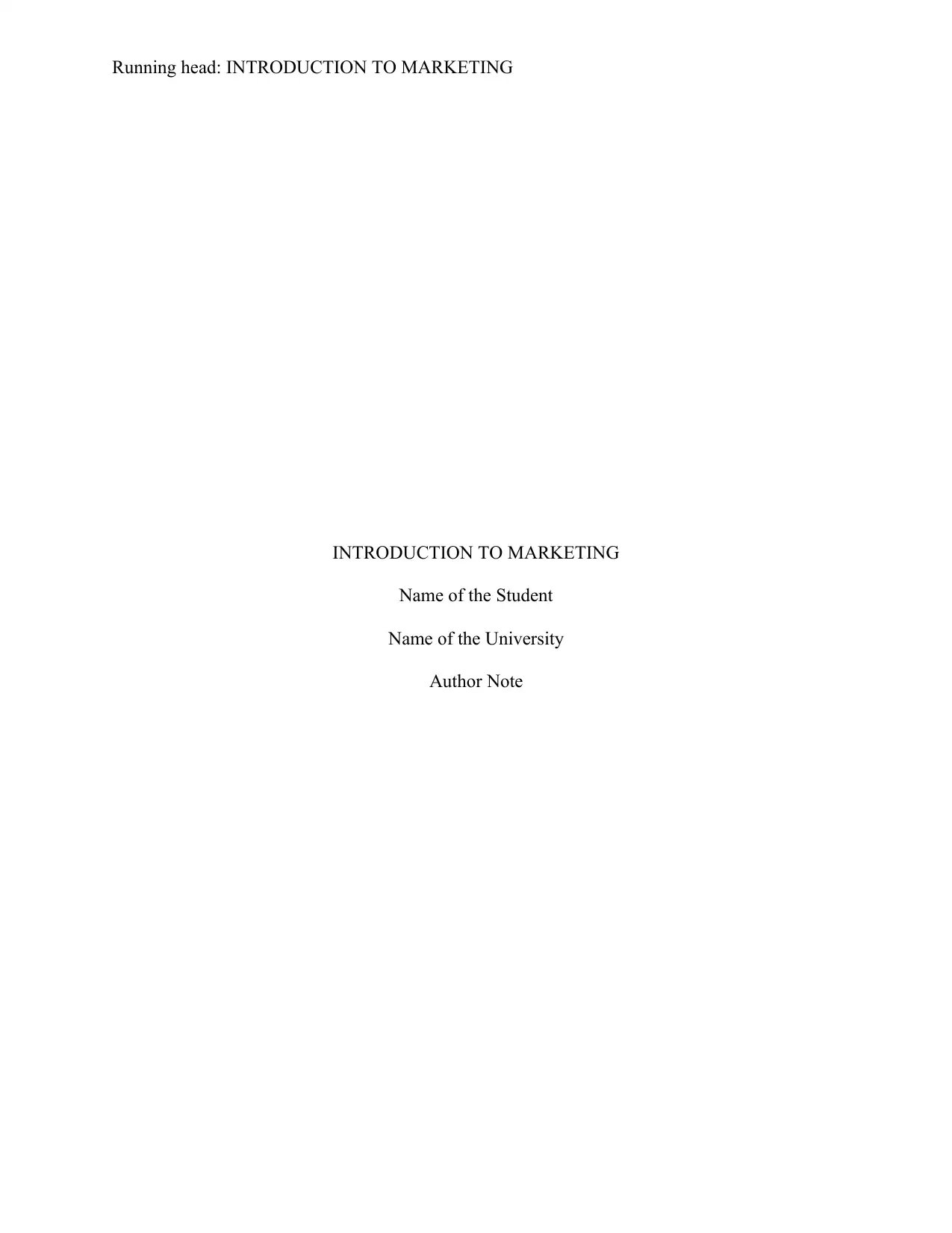
Running head: INTRODUCTION TO MARKETING
INTRODUCTION TO MARKETING
Name of the Student
Name of the University
Author Note
INTRODUCTION TO MARKETING
Name of the Student
Name of the University
Author Note
Paraphrase This Document
Need a fresh take? Get an instant paraphrase of this document with our AI Paraphraser
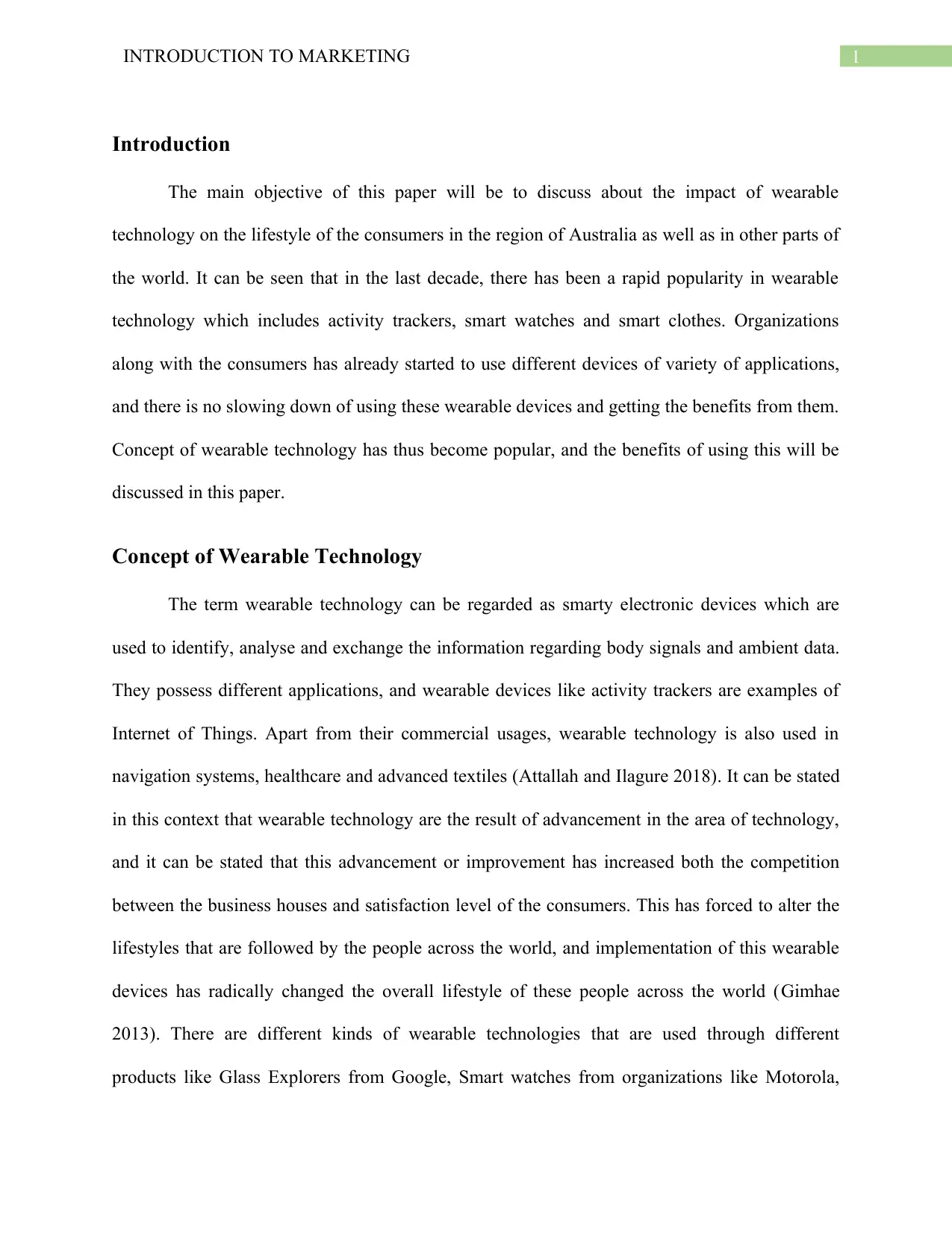
1INTRODUCTION TO MARKETING
Introduction
The main objective of this paper will be to discuss about the impact of wearable
technology on the lifestyle of the consumers in the region of Australia as well as in other parts of
the world. It can be seen that in the last decade, there has been a rapid popularity in wearable
technology which includes activity trackers, smart watches and smart clothes. Organizations
along with the consumers has already started to use different devices of variety of applications,
and there is no slowing down of using these wearable devices and getting the benefits from them.
Concept of wearable technology has thus become popular, and the benefits of using this will be
discussed in this paper.
Concept of Wearable Technology
The term wearable technology can be regarded as smarty electronic devices which are
used to identify, analyse and exchange the information regarding body signals and ambient data.
They possess different applications, and wearable devices like activity trackers are examples of
Internet of Things. Apart from their commercial usages, wearable technology is also used in
navigation systems, healthcare and advanced textiles (Attallah and Ilagure 2018). It can be stated
in this context that wearable technology are the result of advancement in the area of technology,
and it can be stated that this advancement or improvement has increased both the competition
between the business houses and satisfaction level of the consumers. This has forced to alter the
lifestyles that are followed by the people across the world, and implementation of this wearable
devices has radically changed the overall lifestyle of these people across the world (Gimhae
2013). There are different kinds of wearable technologies that are used through different
products like Glass Explorers from Google, Smart watches from organizations like Motorola,
Introduction
The main objective of this paper will be to discuss about the impact of wearable
technology on the lifestyle of the consumers in the region of Australia as well as in other parts of
the world. It can be seen that in the last decade, there has been a rapid popularity in wearable
technology which includes activity trackers, smart watches and smart clothes. Organizations
along with the consumers has already started to use different devices of variety of applications,
and there is no slowing down of using these wearable devices and getting the benefits from them.
Concept of wearable technology has thus become popular, and the benefits of using this will be
discussed in this paper.
Concept of Wearable Technology
The term wearable technology can be regarded as smarty electronic devices which are
used to identify, analyse and exchange the information regarding body signals and ambient data.
They possess different applications, and wearable devices like activity trackers are examples of
Internet of Things. Apart from their commercial usages, wearable technology is also used in
navigation systems, healthcare and advanced textiles (Attallah and Ilagure 2018). It can be stated
in this context that wearable technology are the result of advancement in the area of technology,
and it can be stated that this advancement or improvement has increased both the competition
between the business houses and satisfaction level of the consumers. This has forced to alter the
lifestyles that are followed by the people across the world, and implementation of this wearable
devices has radically changed the overall lifestyle of these people across the world (Gimhae
2013). There are different kinds of wearable technologies that are used through different
products like Glass Explorers from Google, Smart watches from organizations like Motorola,
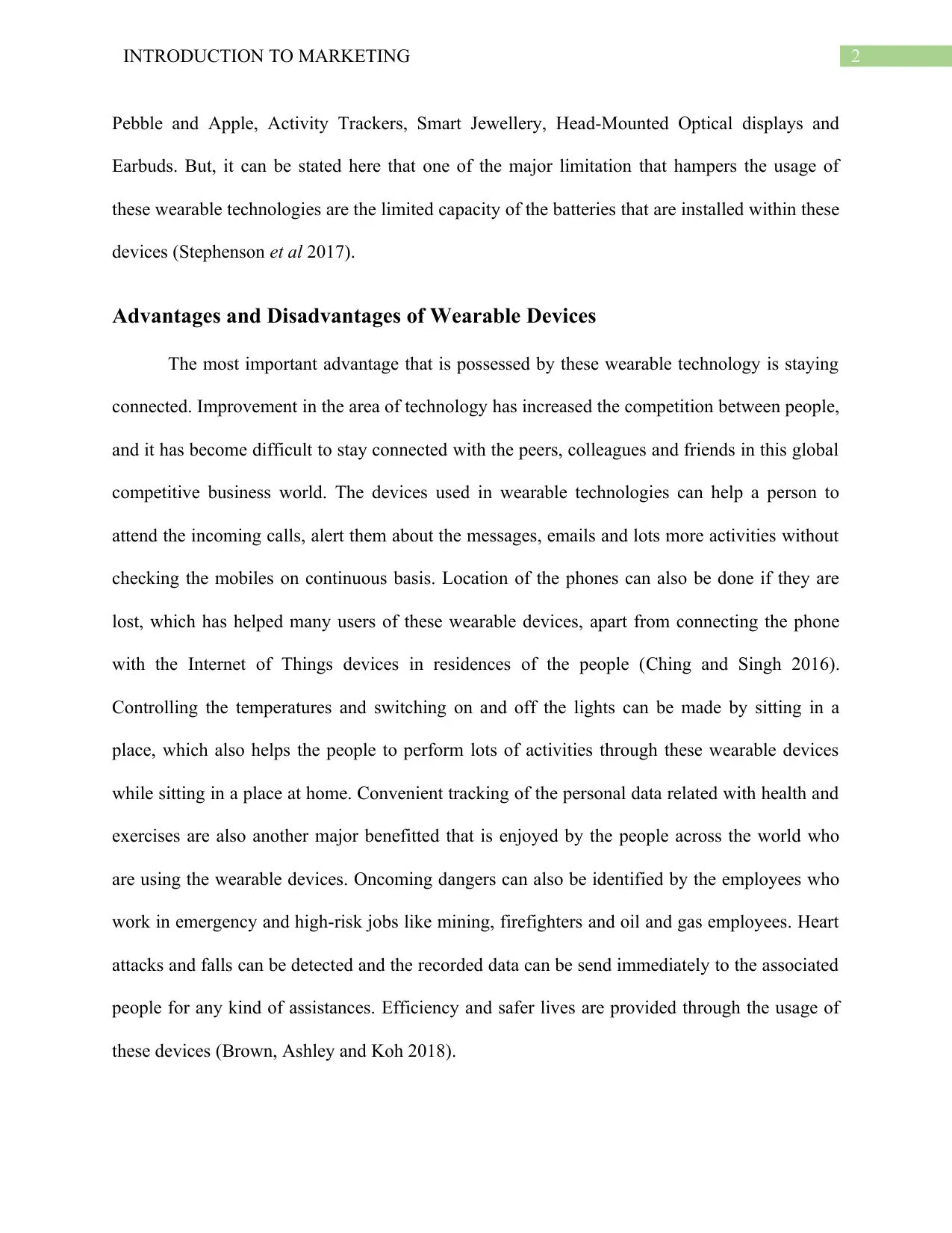
2INTRODUCTION TO MARKETING
Pebble and Apple, Activity Trackers, Smart Jewellery, Head-Mounted Optical displays and
Earbuds. But, it can be stated here that one of the major limitation that hampers the usage of
these wearable technologies are the limited capacity of the batteries that are installed within these
devices (Stephenson et al 2017).
Advantages and Disadvantages of Wearable Devices
The most important advantage that is possessed by these wearable technology is staying
connected. Improvement in the area of technology has increased the competition between people,
and it has become difficult to stay connected with the peers, colleagues and friends in this global
competitive business world. The devices used in wearable technologies can help a person to
attend the incoming calls, alert them about the messages, emails and lots more activities without
checking the mobiles on continuous basis. Location of the phones can also be done if they are
lost, which has helped many users of these wearable devices, apart from connecting the phone
with the Internet of Things devices in residences of the people (Ching and Singh 2016).
Controlling the temperatures and switching on and off the lights can be made by sitting in a
place, which also helps the people to perform lots of activities through these wearable devices
while sitting in a place at home. Convenient tracking of the personal data related with health and
exercises are also another major benefitted that is enjoyed by the people across the world who
are using the wearable devices. Oncoming dangers can also be identified by the employees who
work in emergency and high-risk jobs like mining, firefighters and oil and gas employees. Heart
attacks and falls can be detected and the recorded data can be send immediately to the associated
people for any kind of assistances. Efficiency and safer lives are provided through the usage of
these devices (Brown, Ashley and Koh 2018).
Pebble and Apple, Activity Trackers, Smart Jewellery, Head-Mounted Optical displays and
Earbuds. But, it can be stated here that one of the major limitation that hampers the usage of
these wearable technologies are the limited capacity of the batteries that are installed within these
devices (Stephenson et al 2017).
Advantages and Disadvantages of Wearable Devices
The most important advantage that is possessed by these wearable technology is staying
connected. Improvement in the area of technology has increased the competition between people,
and it has become difficult to stay connected with the peers, colleagues and friends in this global
competitive business world. The devices used in wearable technologies can help a person to
attend the incoming calls, alert them about the messages, emails and lots more activities without
checking the mobiles on continuous basis. Location of the phones can also be done if they are
lost, which has helped many users of these wearable devices, apart from connecting the phone
with the Internet of Things devices in residences of the people (Ching and Singh 2016).
Controlling the temperatures and switching on and off the lights can be made by sitting in a
place, which also helps the people to perform lots of activities through these wearable devices
while sitting in a place at home. Convenient tracking of the personal data related with health and
exercises are also another major benefitted that is enjoyed by the people across the world who
are using the wearable devices. Oncoming dangers can also be identified by the employees who
work in emergency and high-risk jobs like mining, firefighters and oil and gas employees. Heart
attacks and falls can be detected and the recorded data can be send immediately to the associated
people for any kind of assistances. Efficiency and safer lives are provided through the usage of
these devices (Brown, Ashley and Koh 2018).
⊘ This is a preview!⊘
Do you want full access?
Subscribe today to unlock all pages.

Trusted by 1+ million students worldwide
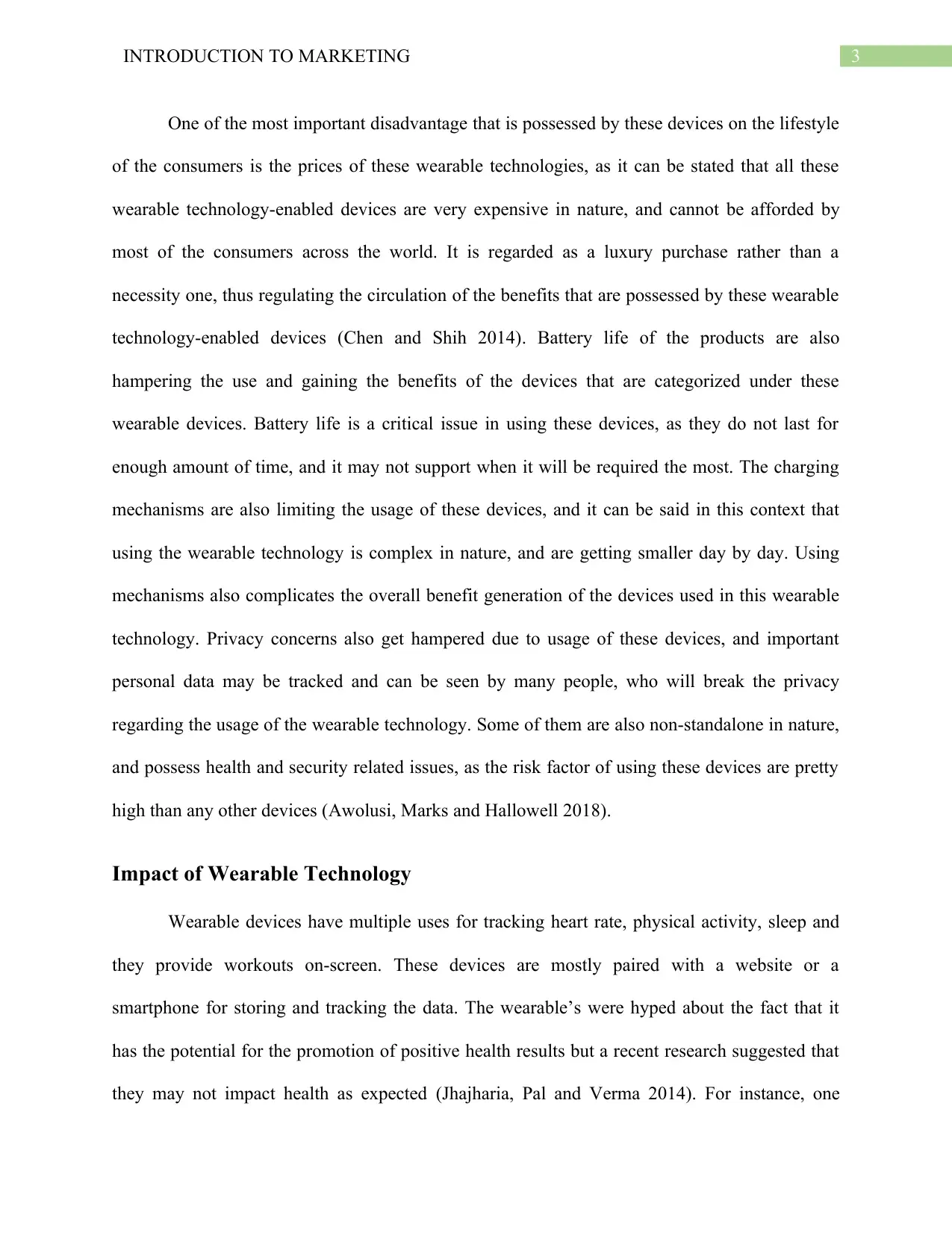
3INTRODUCTION TO MARKETING
One of the most important disadvantage that is possessed by these devices on the lifestyle
of the consumers is the prices of these wearable technologies, as it can be stated that all these
wearable technology-enabled devices are very expensive in nature, and cannot be afforded by
most of the consumers across the world. It is regarded as a luxury purchase rather than a
necessity one, thus regulating the circulation of the benefits that are possessed by these wearable
technology-enabled devices (Chen and Shih 2014). Battery life of the products are also
hampering the use and gaining the benefits of the devices that are categorized under these
wearable devices. Battery life is a critical issue in using these devices, as they do not last for
enough amount of time, and it may not support when it will be required the most. The charging
mechanisms are also limiting the usage of these devices, and it can be said in this context that
using the wearable technology is complex in nature, and are getting smaller day by day. Using
mechanisms also complicates the overall benefit generation of the devices used in this wearable
technology. Privacy concerns also get hampered due to usage of these devices, and important
personal data may be tracked and can be seen by many people, who will break the privacy
regarding the usage of the wearable technology. Some of them are also non-standalone in nature,
and possess health and security related issues, as the risk factor of using these devices are pretty
high than any other devices (Awolusi, Marks and Hallowell 2018).
Impact of Wearable Technology
Wearable devices have multiple uses for tracking heart rate, physical activity, sleep and
they provide workouts on-screen. These devices are mostly paired with a website or a
smartphone for storing and tracking the data. The wearable’s were hyped about the fact that it
has the potential for the promotion of positive health results but a recent research suggested that
they may not impact health as expected (Jhajharia, Pal and Verma 2014). For instance, one
One of the most important disadvantage that is possessed by these devices on the lifestyle
of the consumers is the prices of these wearable technologies, as it can be stated that all these
wearable technology-enabled devices are very expensive in nature, and cannot be afforded by
most of the consumers across the world. It is regarded as a luxury purchase rather than a
necessity one, thus regulating the circulation of the benefits that are possessed by these wearable
technology-enabled devices (Chen and Shih 2014). Battery life of the products are also
hampering the use and gaining the benefits of the devices that are categorized under these
wearable devices. Battery life is a critical issue in using these devices, as they do not last for
enough amount of time, and it may not support when it will be required the most. The charging
mechanisms are also limiting the usage of these devices, and it can be said in this context that
using the wearable technology is complex in nature, and are getting smaller day by day. Using
mechanisms also complicates the overall benefit generation of the devices used in this wearable
technology. Privacy concerns also get hampered due to usage of these devices, and important
personal data may be tracked and can be seen by many people, who will break the privacy
regarding the usage of the wearable technology. Some of them are also non-standalone in nature,
and possess health and security related issues, as the risk factor of using these devices are pretty
high than any other devices (Awolusi, Marks and Hallowell 2018).
Impact of Wearable Technology
Wearable devices have multiple uses for tracking heart rate, physical activity, sleep and
they provide workouts on-screen. These devices are mostly paired with a website or a
smartphone for storing and tracking the data. The wearable’s were hyped about the fact that it
has the potential for the promotion of positive health results but a recent research suggested that
they may not impact health as expected (Jhajharia, Pal and Verma 2014). For instance, one
Paraphrase This Document
Need a fresh take? Get an instant paraphrase of this document with our AI Paraphraser
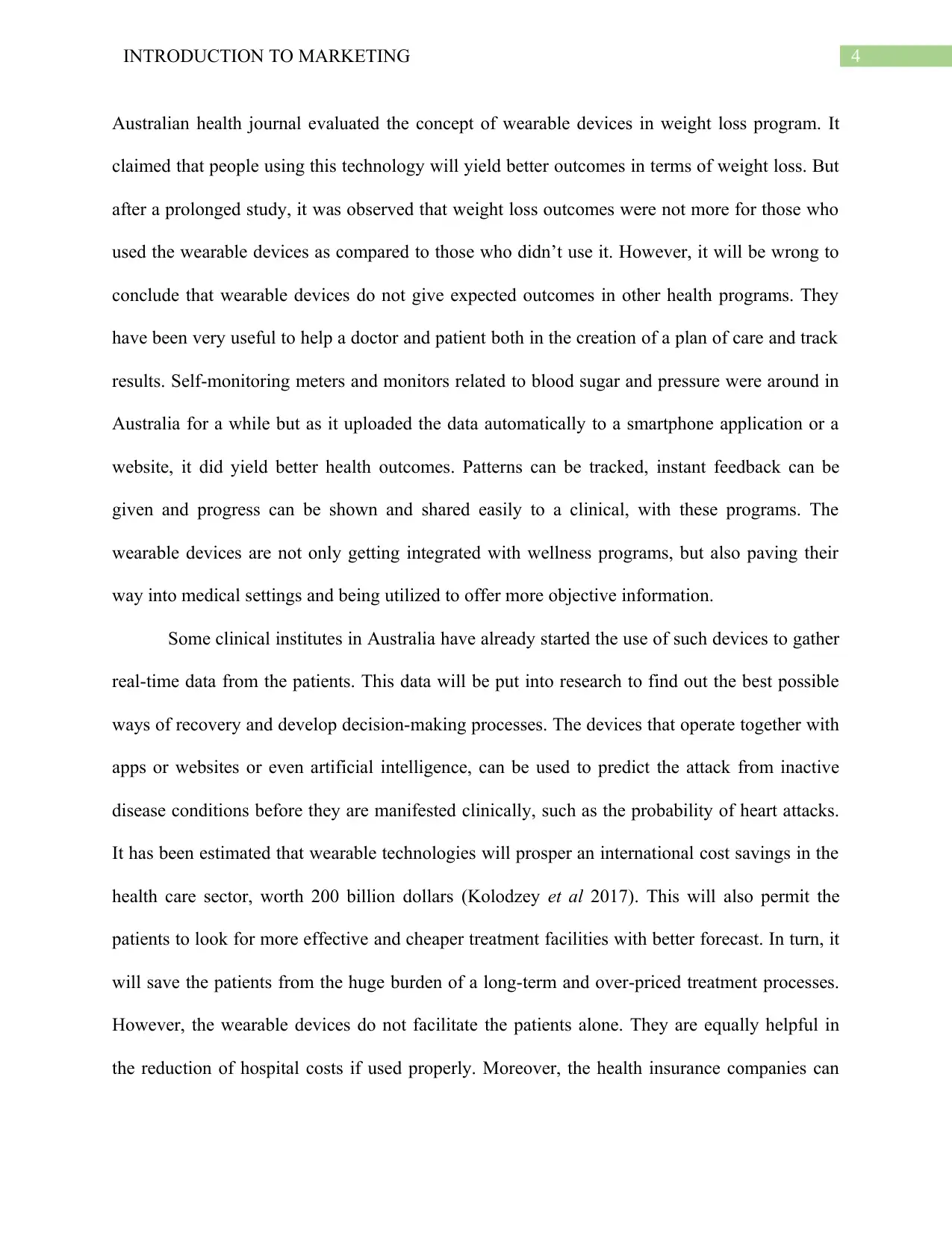
4INTRODUCTION TO MARKETING
Australian health journal evaluated the concept of wearable devices in weight loss program. It
claimed that people using this technology will yield better outcomes in terms of weight loss. But
after a prolonged study, it was observed that weight loss outcomes were not more for those who
used the wearable devices as compared to those who didn’t use it. However, it will be wrong to
conclude that wearable devices do not give expected outcomes in other health programs. They
have been very useful to help a doctor and patient both in the creation of a plan of care and track
results. Self-monitoring meters and monitors related to blood sugar and pressure were around in
Australia for a while but as it uploaded the data automatically to a smartphone application or a
website, it did yield better health outcomes. Patterns can be tracked, instant feedback can be
given and progress can be shown and shared easily to a clinical, with these programs. The
wearable devices are not only getting integrated with wellness programs, but also paving their
way into medical settings and being utilized to offer more objective information.
Some clinical institutes in Australia have already started the use of such devices to gather
real-time data from the patients. This data will be put into research to find out the best possible
ways of recovery and develop decision-making processes. The devices that operate together with
apps or websites or even artificial intelligence, can be used to predict the attack from inactive
disease conditions before they are manifested clinically, such as the probability of heart attacks.
It has been estimated that wearable technologies will prosper an international cost savings in the
health care sector, worth 200 billion dollars (Kolodzey et al 2017). This will also permit the
patients to look for more effective and cheaper treatment facilities with better forecast. In turn, it
will save the patients from the huge burden of a long-term and over-priced treatment processes.
However, the wearable devices do not facilitate the patients alone. They are equally helpful in
the reduction of hospital costs if used properly. Moreover, the health insurance companies can
Australian health journal evaluated the concept of wearable devices in weight loss program. It
claimed that people using this technology will yield better outcomes in terms of weight loss. But
after a prolonged study, it was observed that weight loss outcomes were not more for those who
used the wearable devices as compared to those who didn’t use it. However, it will be wrong to
conclude that wearable devices do not give expected outcomes in other health programs. They
have been very useful to help a doctor and patient both in the creation of a plan of care and track
results. Self-monitoring meters and monitors related to blood sugar and pressure were around in
Australia for a while but as it uploaded the data automatically to a smartphone application or a
website, it did yield better health outcomes. Patterns can be tracked, instant feedback can be
given and progress can be shown and shared easily to a clinical, with these programs. The
wearable devices are not only getting integrated with wellness programs, but also paving their
way into medical settings and being utilized to offer more objective information.
Some clinical institutes in Australia have already started the use of such devices to gather
real-time data from the patients. This data will be put into research to find out the best possible
ways of recovery and develop decision-making processes. The devices that operate together with
apps or websites or even artificial intelligence, can be used to predict the attack from inactive
disease conditions before they are manifested clinically, such as the probability of heart attacks.
It has been estimated that wearable technologies will prosper an international cost savings in the
health care sector, worth 200 billion dollars (Kolodzey et al 2017). This will also permit the
patients to look for more effective and cheaper treatment facilities with better forecast. In turn, it
will save the patients from the huge burden of a long-term and over-priced treatment processes.
However, the wearable devices do not facilitate the patients alone. They are equally helpful in
the reduction of hospital costs if used properly. Moreover, the health insurance companies can

5INTRODUCTION TO MARKETING
incorporate their insurance plans with the wearable technologies in order to translate a crop of
healthier clients along with lesser claims. At the same moment, it should be noted that such
devices possess very less security measures to keep the customer data safe. Most of the data is
unscripted and since they operate with the help of Wi-Fi or Bluetooth connections,
cybercriminals may find it easy to get access to it. But wearable have the capability to evolve
continuously which means that it will develop higher-priority targets (Slade Shantz and Veillette
2014).
Conclusion
From the above discussion, it can ne stated that the impact of wearable technology is
huge in the lifestyle of the consumers globally, where different kinds of data can be monitored
and gathered to analyse them according to their requirement of the people who are using this
(Yano et al 2015). Though there are disadvantages of using these devices, still it has changed the
lifestyle of the people who are also using the devices from the viewpoint of fashion statement.
The lifestyle of these global consumers has thus hugely impacted by these wearable technology,
and people has already started to use these devices from wearable technology to get the benefits
used of the devices which are mentioned earlier in this paper. It has both impacted positively and
negatively on the life of the consumers, but the positivity are more than the negative effects.
incorporate their insurance plans with the wearable technologies in order to translate a crop of
healthier clients along with lesser claims. At the same moment, it should be noted that such
devices possess very less security measures to keep the customer data safe. Most of the data is
unscripted and since they operate with the help of Wi-Fi or Bluetooth connections,
cybercriminals may find it easy to get access to it. But wearable have the capability to evolve
continuously which means that it will develop higher-priority targets (Slade Shantz and Veillette
2014).
Conclusion
From the above discussion, it can ne stated that the impact of wearable technology is
huge in the lifestyle of the consumers globally, where different kinds of data can be monitored
and gathered to analyse them according to their requirement of the people who are using this
(Yano et al 2015). Though there are disadvantages of using these devices, still it has changed the
lifestyle of the people who are also using the devices from the viewpoint of fashion statement.
The lifestyle of these global consumers has thus hugely impacted by these wearable technology,
and people has already started to use these devices from wearable technology to get the benefits
used of the devices which are mentioned earlier in this paper. It has both impacted positively and
negatively on the life of the consumers, but the positivity are more than the negative effects.
⊘ This is a preview!⊘
Do you want full access?
Subscribe today to unlock all pages.

Trusted by 1+ million students worldwide
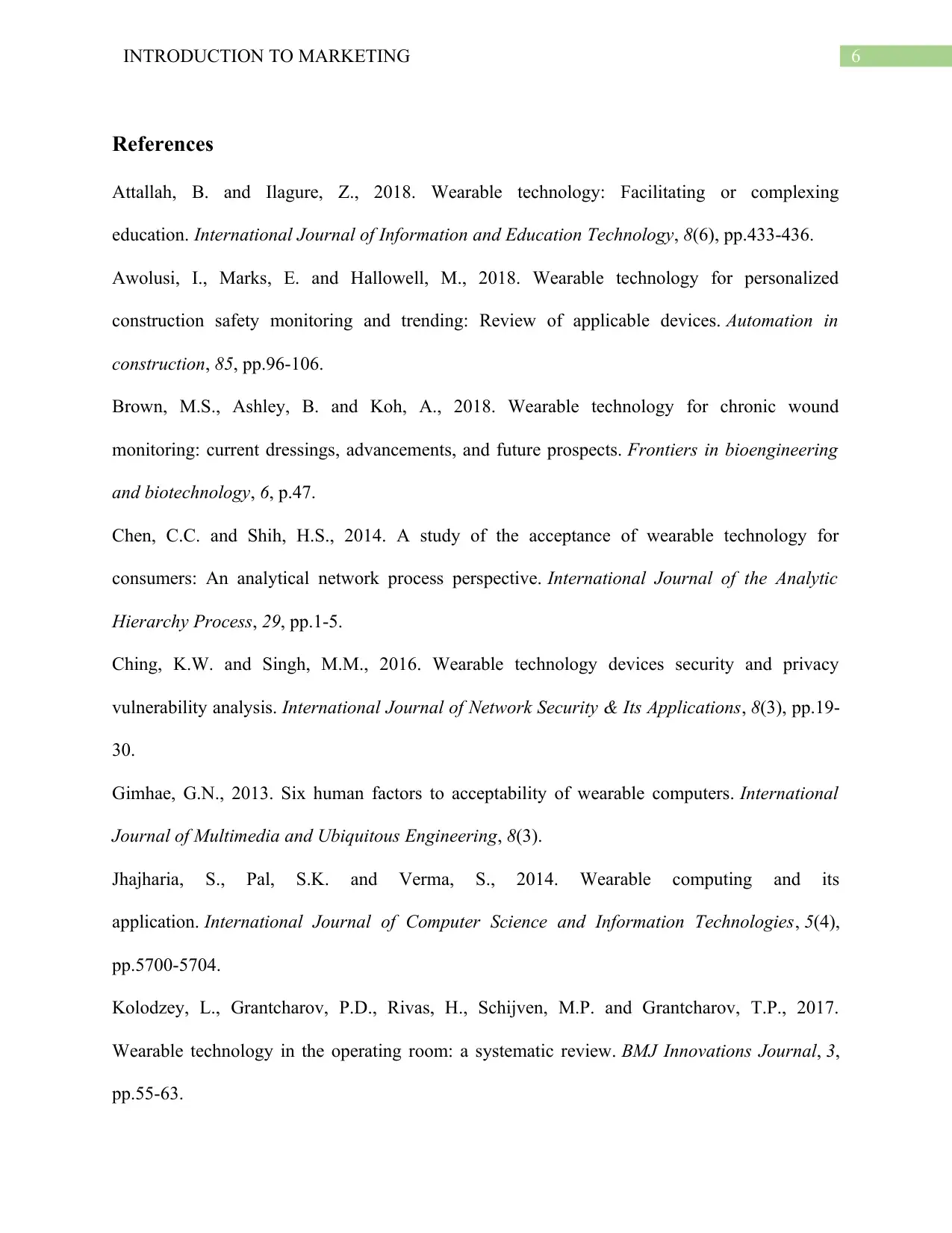
6INTRODUCTION TO MARKETING
References
Attallah, B. and Ilagure, Z., 2018. Wearable technology: Facilitating or complexing
education. International Journal of Information and Education Technology, 8(6), pp.433-436.
Awolusi, I., Marks, E. and Hallowell, M., 2018. Wearable technology for personalized
construction safety monitoring and trending: Review of applicable devices. Automation in
construction, 85, pp.96-106.
Brown, M.S., Ashley, B. and Koh, A., 2018. Wearable technology for chronic wound
monitoring: current dressings, advancements, and future prospects. Frontiers in bioengineering
and biotechnology, 6, p.47.
Chen, C.C. and Shih, H.S., 2014. A study of the acceptance of wearable technology for
consumers: An analytical network process perspective. International Journal of the Analytic
Hierarchy Process, 29, pp.1-5.
Ching, K.W. and Singh, M.M., 2016. Wearable technology devices security and privacy
vulnerability analysis. International Journal of Network Security & Its Applications, 8(3), pp.19-
30.
Gimhae, G.N., 2013. Six human factors to acceptability of wearable computers. International
Journal of Multimedia and Ubiquitous Engineering, 8(3).
Jhajharia, S., Pal, S.K. and Verma, S., 2014. Wearable computing and its
application. International Journal of Computer Science and Information Technologies, 5(4),
pp.5700-5704.
Kolodzey, L., Grantcharov, P.D., Rivas, H., Schijven, M.P. and Grantcharov, T.P., 2017.
Wearable technology in the operating room: a systematic review. BMJ Innovations Journal, 3,
pp.55-63.
References
Attallah, B. and Ilagure, Z., 2018. Wearable technology: Facilitating or complexing
education. International Journal of Information and Education Technology, 8(6), pp.433-436.
Awolusi, I., Marks, E. and Hallowell, M., 2018. Wearable technology for personalized
construction safety monitoring and trending: Review of applicable devices. Automation in
construction, 85, pp.96-106.
Brown, M.S., Ashley, B. and Koh, A., 2018. Wearable technology for chronic wound
monitoring: current dressings, advancements, and future prospects. Frontiers in bioengineering
and biotechnology, 6, p.47.
Chen, C.C. and Shih, H.S., 2014. A study of the acceptance of wearable technology for
consumers: An analytical network process perspective. International Journal of the Analytic
Hierarchy Process, 29, pp.1-5.
Ching, K.W. and Singh, M.M., 2016. Wearable technology devices security and privacy
vulnerability analysis. International Journal of Network Security & Its Applications, 8(3), pp.19-
30.
Gimhae, G.N., 2013. Six human factors to acceptability of wearable computers. International
Journal of Multimedia and Ubiquitous Engineering, 8(3).
Jhajharia, S., Pal, S.K. and Verma, S., 2014. Wearable computing and its
application. International Journal of Computer Science and Information Technologies, 5(4),
pp.5700-5704.
Kolodzey, L., Grantcharov, P.D., Rivas, H., Schijven, M.P. and Grantcharov, T.P., 2017.
Wearable technology in the operating room: a systematic review. BMJ Innovations Journal, 3,
pp.55-63.
Paraphrase This Document
Need a fresh take? Get an instant paraphrase of this document with our AI Paraphraser
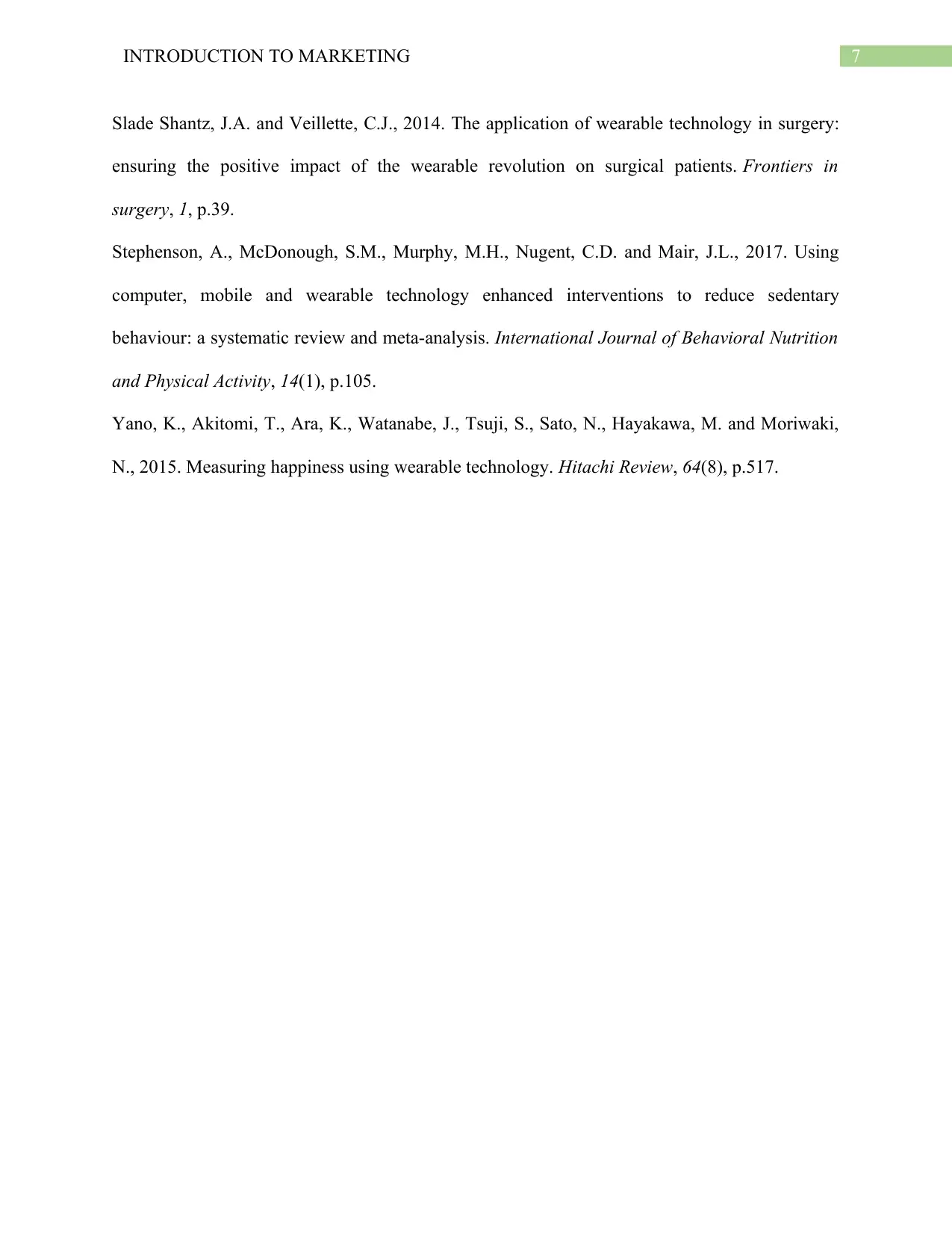
7INTRODUCTION TO MARKETING
Slade Shantz, J.A. and Veillette, C.J., 2014. The application of wearable technology in surgery:
ensuring the positive impact of the wearable revolution on surgical patients. Frontiers in
surgery, 1, p.39.
Stephenson, A., McDonough, S.M., Murphy, M.H., Nugent, C.D. and Mair, J.L., 2017. Using
computer, mobile and wearable technology enhanced interventions to reduce sedentary
behaviour: a systematic review and meta-analysis. International Journal of Behavioral Nutrition
and Physical Activity, 14(1), p.105.
Yano, K., Akitomi, T., Ara, K., Watanabe, J., Tsuji, S., Sato, N., Hayakawa, M. and Moriwaki,
N., 2015. Measuring happiness using wearable technology. Hitachi Review, 64(8), p.517.
Slade Shantz, J.A. and Veillette, C.J., 2014. The application of wearable technology in surgery:
ensuring the positive impact of the wearable revolution on surgical patients. Frontiers in
surgery, 1, p.39.
Stephenson, A., McDonough, S.M., Murphy, M.H., Nugent, C.D. and Mair, J.L., 2017. Using
computer, mobile and wearable technology enhanced interventions to reduce sedentary
behaviour: a systematic review and meta-analysis. International Journal of Behavioral Nutrition
and Physical Activity, 14(1), p.105.
Yano, K., Akitomi, T., Ara, K., Watanabe, J., Tsuji, S., Sato, N., Hayakawa, M. and Moriwaki,
N., 2015. Measuring happiness using wearable technology. Hitachi Review, 64(8), p.517.
1 out of 8
Related Documents
Your All-in-One AI-Powered Toolkit for Academic Success.
+13062052269
info@desklib.com
Available 24*7 on WhatsApp / Email
![[object Object]](/_next/static/media/star-bottom.7253800d.svg)
Unlock your academic potential
Copyright © 2020–2025 A2Z Services. All Rights Reserved. Developed and managed by ZUCOL.





